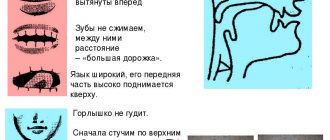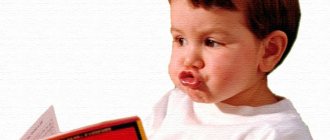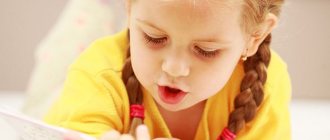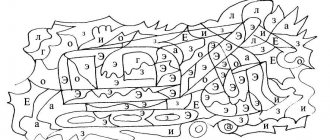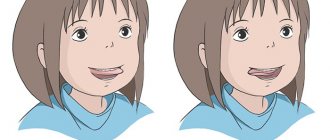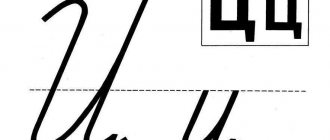Abstract of the GCD “The Enchanted Forest. Sound {l *}". Literacy training, senior group.
Title: Abstract of the GCD “The Enchanted Forest. Sound {l *}". Literacy training, senior group. Nomination: Kindergarten, Lesson notes, GCD, literacy training, senior group Author: Elena Borisovna Perveeva Position: senior teacher Place of work: MBDOU kindergarten No. 6 in Zadonsk, Lipetsk region Location: Zadonsk city, Lipetsk region
Summary of organized educational activities on speech development (sound culture of speech) in the senior group.
Compiled by: senior teacher of MBDOU kindergarten No. 6 in Zadonsk, Lipetsk region Elena Borisovna Perveeva.
Topic: “Journey to the enchanted forest. Sound [l*]"
Program tasks: consolidating the pronunciation of the sound [l*], developing the ability to correctly pronounce consonant sounds, articulating vowel sounds, determining the place of a sound in a word, sound analysis of words, consolidating the ability to compose sentences; development of auditory attention, memory, fine motor skills; fostering a sense of mutual assistance and responsibility for one’s actions.
Equipment: subject pictures (deer, bumblebee, heron, snail, frog), pencil cases (with red, green, blue circles), table mirrors, a hare toy, a spider toy, task cards, a fly agaric model with riddles, threads.
OOD progress.
I. Organizational moment. - Are you guys in a good mood today? If not everyone has it, then let's improve it! Psycho-gymnastics “Smile”: Let’s quickly gather in a circle, Let’s hold hands together. We will smile at each other! - Everyone is in a good mood now. I suggest going to visit the hare Stepashka in the forest. He invited us to his place today. Do you agree? - But he’s late for some reason. Has something really happened? (The teacher brings in a toy hare.) - Stepashka, hello. Tell me what happened? (The teacher speaks on behalf of the hare). - Silent people came to our forest. Everything in the forest froze: the birds stopped singing, the noise of the grass, the usual hubbub of the forest could not be heard. The forest is sleeping. He needs to be woken up. But this can be done by those who can speak well, know sounds well, and know how to compose sentences. Do you agree to help the forest? II. Main part. 1. Working with sounds. 1) Articulation. - Stepashka, we are ready to help you, but first we will prepare for such difficult tasks. - Guys, sit down at the tables, pull up the mirrors. Let's do exercises for the lips and tongue. (Children, each in front of their mirror, perform articulation exercises “Fence”, “Smile”, “Tube”, “Spatula”, “Clock”, “Swing”, “Horse”). - Now we are ready to go into the forest. 2) Isolation of sound among a number of others. - In front of us is the entrance to the forest, a dangerous guard sits at the entrance. (Place 2 tall indoor plants and hang a toy spider and a task card between them on threads). - Let's read and complete the tasks. No. 1 “Name all the vowel sounds.” No. 2 “What sound does the word forest begin with?” No. 3 “Clap your hands if you hear the sound [l*] among other sounds.” (For task No. 3, you can list any sounds: [s*], [l], [n*], [p*], [m], [d*], [k]). 3) Pure statements. - We can go into the forest. (The teacher breaks the threads.) - While we are walking along the path, repeat after me the simple sayings: Li-li-li - here we are in the forest. Va-va-va - and there is grass in the forest. If only there were mushrooms in the grass. Wee-wee-wee – don’t tear them all up. 4) Determining the place of sound in a word. - What an interesting mushroom! (The teacher shows a fly agaric with riddles.) - What is this mushroom called? — There is something written on his white peas. And next to the mushroom is card No. 2. We read the task: “Unspell the forest inhabitants by solving riddles and determining the place of the sound [l*] in the guess word.” a) We are green like grass, Our song: “Kva-kva.” (Frog is the first)
b) The tower is crawling, a rich, horned mistress is carrying it on its back. (Snail is the second)
c) He stands on one leg and looks intently into the water. Poking at random with its beak - Looking for frogs in the river. (Heron - fourth)
d) Flies - buzzes, Sits on a flower - is silent. And if he bites, then everyone screams. (Bumblebee is the last one)
d) Touching the grass with his hooves, a handsome man walks around the yard. He walks boldly and easily, with his horns spread wide. (Deer is second)
(As soon as the children guess the riddle, the teacher turns over the pictures on the typesetting canvas and clarifies the place of the sound [l*] in the word.) - Guys, you have revived the bumblebee, it will fly to the flowers and herbs and wake them up; revived the snail - it will wake up the insects; frog - all river inhabitants; heron - all birds; deer - all animals.
2. Work on word combinations. - What beautiful inhabitants of the forest! For example, people say not just a deer, but a red deer. And what kind of deer (frog, snail, bumblebee, heron)? (Children's approximate answers: deer - horned, tall, fast, handsome; snail - slow, small, crawling; frog - green, spotted, swamp; heron - white, winged, long-legged; bumblebee - striped, dangerous, buzzing).
3. Physical education minute. - Guys, look at the clearing we find ourselves in! Let's rest on it. We came out to the forest meadow, lifting our legs higher, through the bushes and hummocks, through the branches and stumps. Who walked so high - Didn’t stumble, didn’t fall!
4. Sound analysis of the word. — We approached the forest school. Here's another card. What is written here? Card No. 3 “Guess the word and give its analysis.” (Anagram card with words and pictures: Leaf-Needle-Dog-Watermelon). (Children guess the word.) - What sound does the word leaf begin with? — What sound does the word needle begin with? — What sound does the word dog begin with? — What sound does the word watermelon begin with? - What word did you get? - Let's sit down at the tables, take our pencil cases and turn over the cards with the word fox. - How many syllables are in a word? (Two) - How did you determine? (Clap, chin) - Name the first syllable. (Lee) - Name the second syllable. (Sa) - How many sounds are in a word? (4) - Name the first sound (second, third, fourth). [l*] – consonant, soft, green circle from a pencil case, [i] – vowel, red circle, [s] – consonant, hard, blue circle, [a] – vowel, red circle. (Children take turns pronouncing and laying out circles in the diagram.) - Well done, you coped with this task.
5. Work on proposals. - And here is card No. 4 “Make sentences with words.” - And with what words? There is a note here: “Define these words yourself by completing the sentences correctly.” a) Yellow is shining high in the sky... (sun) b) In the forest there are a lot of green, prickly... (firs) c) Wild berries are turning red in the grass... (strawberries) d) Ripe ones are hanging on an oak tree... (acorns) e) Sitting high on a tree goggle-eyed... (owl) f) A mustachioed one is crawling along a leaf... (beetle) - Now each of you needs to make up your own sentence with one of these pictures. (Children make sentences based on the selected picture.) - So we have completed all the tasks! - Let's tell the poem we taught about the forest. So that the pines, lindens, spruces do not get sick, so that they turn green, so that new forests rise to the skies. They are guarded by a friend - a forester, accompanied by the ringing and hubbub of birds! - Guys, who is the forester? Who can tell you about this profession? (If the children find it difficult, the teacher himself talks about the forester.)
III. Summing up. —Where and with whom did we travel today? — How did we help the forest? What did we do for this? — Which task was easy for whom to complete? - Stepashka, if anything else happens, come to us for help. We will definitely help. Or just come and visit us. We will be glad to see you again. Goodbye! Perspective. - And for you guys, there is a task, what you did today, draw and continue the album “Sound Staircase”.
Date modified: November 17, 2016
Topic: “Sound [L]. Letter L"
Target:
- Introduce the sound [L] and the letter L.
Tasks:
Correctional and educational:
- clarification of the articulation of sound [L];
- development of phonemic hearing and perception;
- identifying a given sound by ear;
- compilation of sound characteristics;
- determining the location of sound in words;
- the use in speech of complex sentences with the meaning of opposition;
- the use of prepositional constructions of the instrumental case in speech; sound-letter analysis of the word “lama”;
- acquaintance with the letter L;
- learn to listen carefully to an adult’s speech, correctly understand logical and grammatical structures and answer questions;
Correctional and developmental:
- develop phonemic perception, visual attention, memory, thinking;
Correctional and educational:
- develop independence, perseverance, and the ability to work in a team.
Equipment:
- subject pictures; letter boxes, blue pencils, charts for reading syllables.
Progress of the lesson
Organizing time
Children stand near the speech therapist.
Speech therapist: Today I have prepared riddles for you, listen carefully, whoever guesses raises his hand. I will open the pictures of the answer on the board.
Puzzles
An angry grandfather sits in the ground. Dressed in a yellow fur coat, Whoever undresses him sheds tears. (ONION)
Lights up the way at night, doesn't let the stars sleep. Let everyone sleep, she has no time for sleep, There is light in the sky for us... (MOON)
Who is wearing a bright red beret, In a black satin cap? He doesn't look at me, He keeps knocking, knocking, knocking (WOODPECKER)
Four legs, seat and back. We are not horses, although everyone sits on us many times. (CHAIR)
I am the most energetic worker in the workshop, I beat as hard as I can all day long. (HAMMER)
It slips away like something alive, but I won’t let it go. It foams with white foam, I’m not too lazy to wash my hands. (SOAP)
L: Well done, and now I’ll say the guess words again, and I’ll highlight one sound with my voice. You should guess which sound I highlighted.
- Bow, moon, shovel, chair, hammer, soap.
Children - sound [L].
I. Introducing the sound [L]
1. Sound characteristics.
Speech therapist - listen to how this sound sounds - [l,,,l,,,l]. Now this sound will be uttered by Masha, Varya...
Tell me what sound it is - consonant, hard. Why did you decide so? (can’t sing, teeth and tongue get in the way)
L - that's right, now cover your ears with your palms and say the sound again. What else can you say about the sound [l]?
Children - he is loud.
L - if the sound is consonant, hard, then what sound symbol will we use to denote it?
D - blue circle.
2. L - and now let’s play the game “ Find the place of the sound in the word ” (using the guessing pictures) - name an object where the sound [L] is at the beginning of the word, in the middle of the word, at the end of the word. (There are diagrams on the board above words, and children post pictures under them)
Children line up in a circle.
3. L- Let's play the game “ Repeat without a mistake .” Development of phonemic hearing, pronunciation of syllable chains with vowel replacement (lo-lu-la...)
The children sit at the tables.
4. L - there are two pictures in front of you.
Didactic exercise “Find the difference”
Children compare objects: “In the first picture there is a boat, but in the second picture there is no boat.”
Didactic exercise “Find a place”
L - between what objects is the shovel located?
D - the shovel is located between the bow and the boat.
Physical education minute
(performing movements while speaking the text)
The flat boat floated; there were two oars in the boat. And the frogs on the oars swam merrily somewhere.
II. Introducing the letter L
L - what does the letter L look like?
Guess, look. Maybe it's a tick - Consists of sticks. The corner is the exact form, the letter stands exactly like this.
1. L - children, remind us how a sound differs from a letter!
(D - we hear and pronounce sounds, but we see and write the letter).
L - the letter L can be capitalized or small. Why is a capital letter needed?-
D - to write first name, last name, animal names, city name...
2. Reading reverse and forward syllables according to patterns . Reading syllables with a confluence (sla, slo, slu, sly, shla, shlo, shlu, shly)
3. Work at the cash registers.
L - you have the letters L on your tables, capital and small. Open the cash registers and move new residents into your apartment.
On the board there is a picture with the animal LAMA.
Laying out the word at the box office - LAMA, sound analysis of the word. Dividing a word into syllables.
L - how many sounds are in the first syllable, name the first syllable. How many sounds are in the second syllable, name the second syllable.
Laying out the syllabic pattern
Finger gymnastics “Here are the needles and pins”
